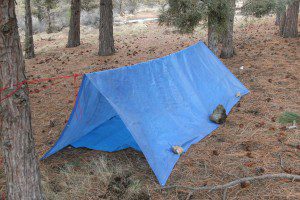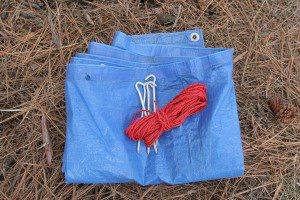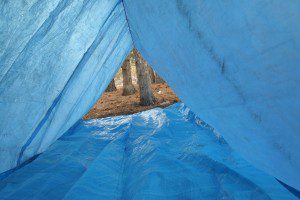It was a bad time for the weather to get really nasty. The angry, black clouds threatened snow and boiled over the nearby mountains as they headed toward us. My brother Mike and I were on an elk hunt, and had backpacked miles back from any road into Idaho’s Clearwater National Forest.
 This emergency tarp shelter is quick to set up and the components are easily-carried. In an emergency, you will probably not have the time and necessary skills to make a waterproof shelter out of native materials.
This emergency tarp shelter is quick to set up and the components are easily-carried. In an emergency, you will probably not have the time and necessary skills to make a waterproof shelter out of native materials.Because we had to go light, our only shelter was two blue plastic tarps. We looked around quickly, tied a line between two trees that were about 15 feet apart, and quickly set the 10-by-12-foot across it in an A-Frame fashion. We set the tarp so the uphill tree’s dripline would hit it about two feet downhill. We anchored the edges and corners with rocks.
The other tarp was placed inside as a ground cover. The uphill edges were raised with rocks, so water would flow around the sleeping bags, backpacks and rifles that were stacked on it.
TV survival shows to the contrary, it is virtually impossible to make a waterproof shelter out of natural materials, even if you have the time, tools and practice! Even with a tarp, you must have some idea or plan on how to fashion a refuge from the elements.Eureka Tetragon 5 Adventure 7-Foot by 5-Foot Two-Person Tent
Setting up our tarp shelter took less than five minutes, and then the wind and rain hit. For the next 15 hours, as the rain fell steadily, we slept, snoozed and talked. There was no interior condensation problem, and we could cook without danger of asphyxiation. Neither of us got wet or cold at all, and I doubt a tent could have served us as well.
I hiked the more than 200 miles of the John Muir Trail; two weeks and 100 or so miles through the Yellowstone backcountry, and completed several shorter mountain trips with only a tarp as my shelter. On these trips, my choice of shelter was made deliberately to lighten my backpack.
If you decide to go tarp camping, and use the A-Frame style, here’s what you need to take along:
 A tarp, 50 feet of parachute cord or light rope and four aluminum tent stakes are the basis of a quick shelter.
A tarp, 50 feet of parachute cord or light rope and four aluminum tent stakes are the basis of a quick shelter.- Knowledge: Learn functional knots to secure the cord at each end. Handbook of Knots: EXPANDED EDITION
Know your trees: find two about 15 to 20 feet apart, with a slight elevation difference, so any moisture will drain. Stand between these trees and look up to check for dead branches that could fall. Know how to improvise if there aren’t appropriate trees. Practice setting up this shelter before you head out! - Large (My favorite size is about eight by ten foot) tarp with sturdy grommets at the corners and middle for the covering. 6 ft. x 8 ft. Ultralight Backpacking Tarp
- Smaller, waterproof tarp, groundcloth or poncho for the floor. Remember to elevate the edges for water runoff Sea to Summit Ultra-Sil Tarp-Poncho
. - Lots of parachute cord or light rope. Take a minimum of 25 feet. I always take about 100 feet. The cord is light, compact and you’ll always find a use for it! 50-Ft 550 Parachute Cord Military 7-Strand Camping Survival – COLOR MAY VARY
- Four aluminum tent stakes. These can be used if there is a shortage of rocks in the area. They can also be helpful if you decide to modify the basic design Sierra Designs Hex Peg Tent Stakes
.
This tip came from my college roommate, Bob Patterson, of Mankato, Mn. Bob camps year-round in the frozen north!
 Place a smaller tarp or ponch inside the A-Frame, with the edges raised. This will provide a dry sleeping area, and will keep water from draining downhill onto your gear.
Place a smaller tarp or ponch inside the A-Frame, with the edges raised. This will provide a dry sleeping area, and will keep water from draining downhill onto your gear.“One cold weather wrinkle on the A-Frame with no poncho is to stack pine boughs and moss on the outside and line the floor with pine boughs,” Bob wrote. “Then stuff it full of leaves, moss, or whatever, and burrow down inside of it like a squirrel’s nest. It’s better than sitting up all night under a tree!”
If wet or nasty weather is anticipated, take along a tent appropriate for the season. If you are headed on a winter campout, or into an area with mosquitoes and/or the potential for creepy, crawly visitors at night, take a tent with mosquito netting Eureka Solo Backcountry 1 Tent
.
In other instances, though, the A -Frame tarp shelter may be all you need, and sometimes may be the best choice!
For more related Survival Common Sense tips, click on the highlighted words:
- STOP: Use this exercise to reduce stress and focus your thoughts.
- Write a note to let people know where you went, before you left.
- Take your Ten Essentials on every outing.
- Dress with the right fabrics



Leave a Reply